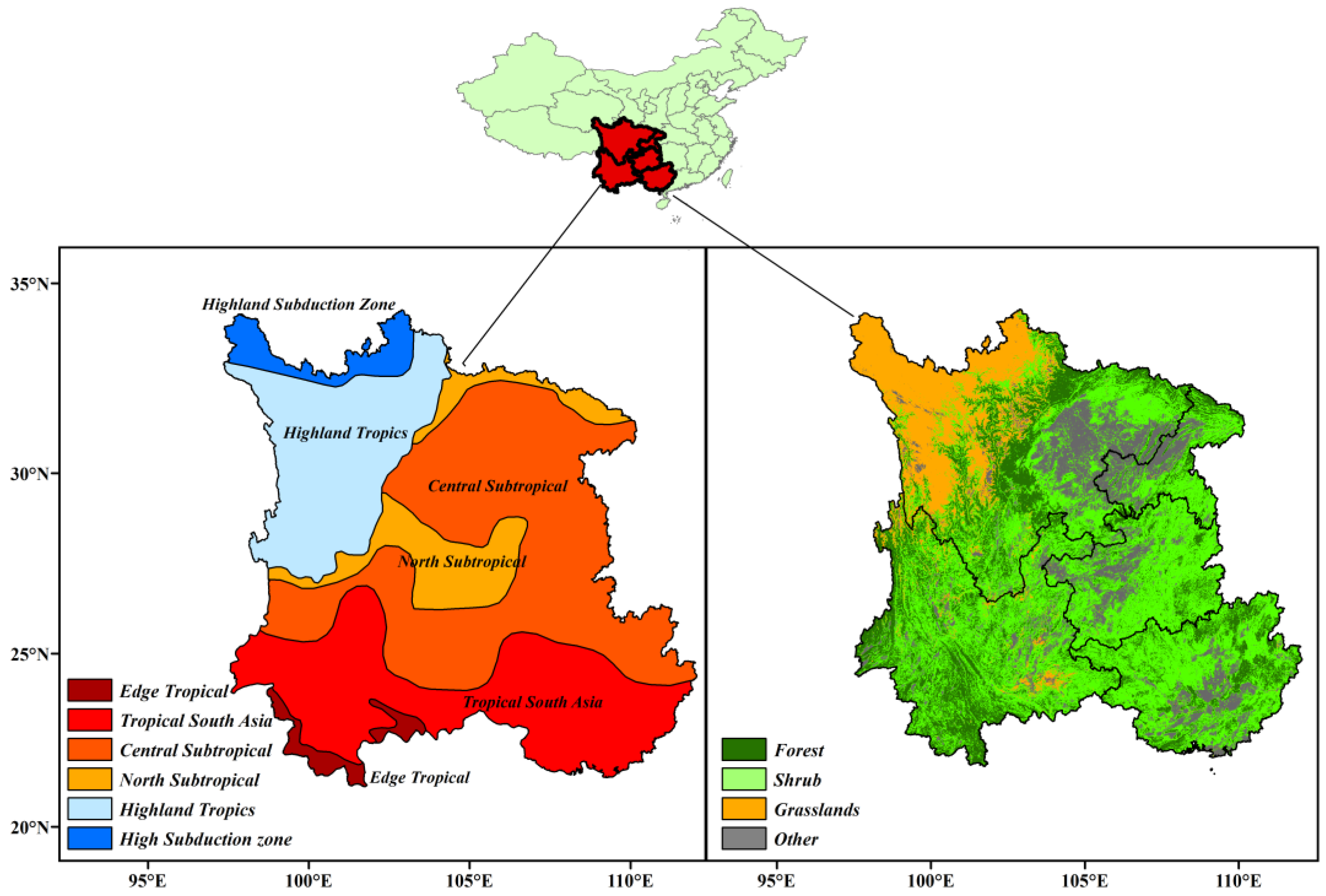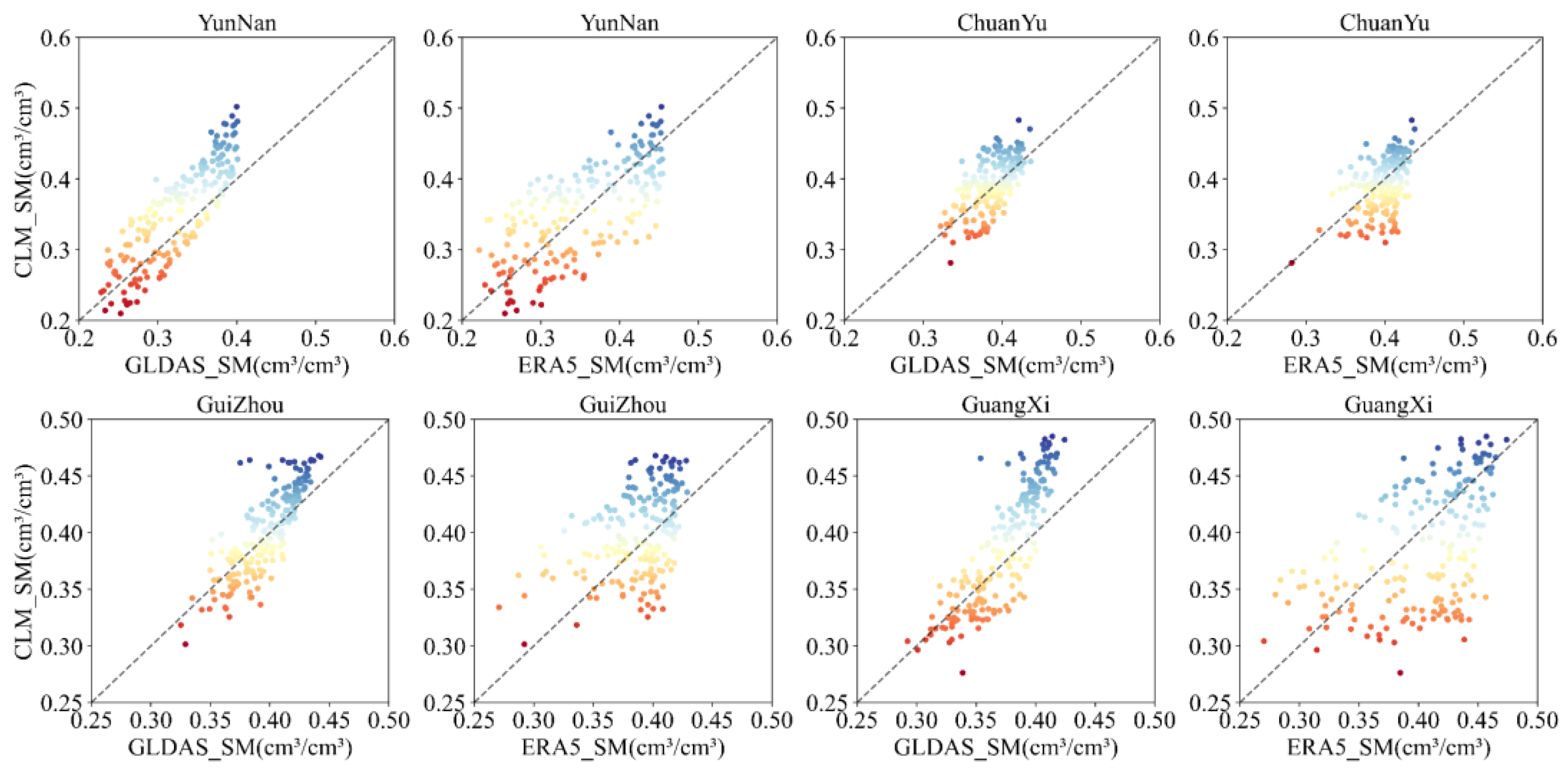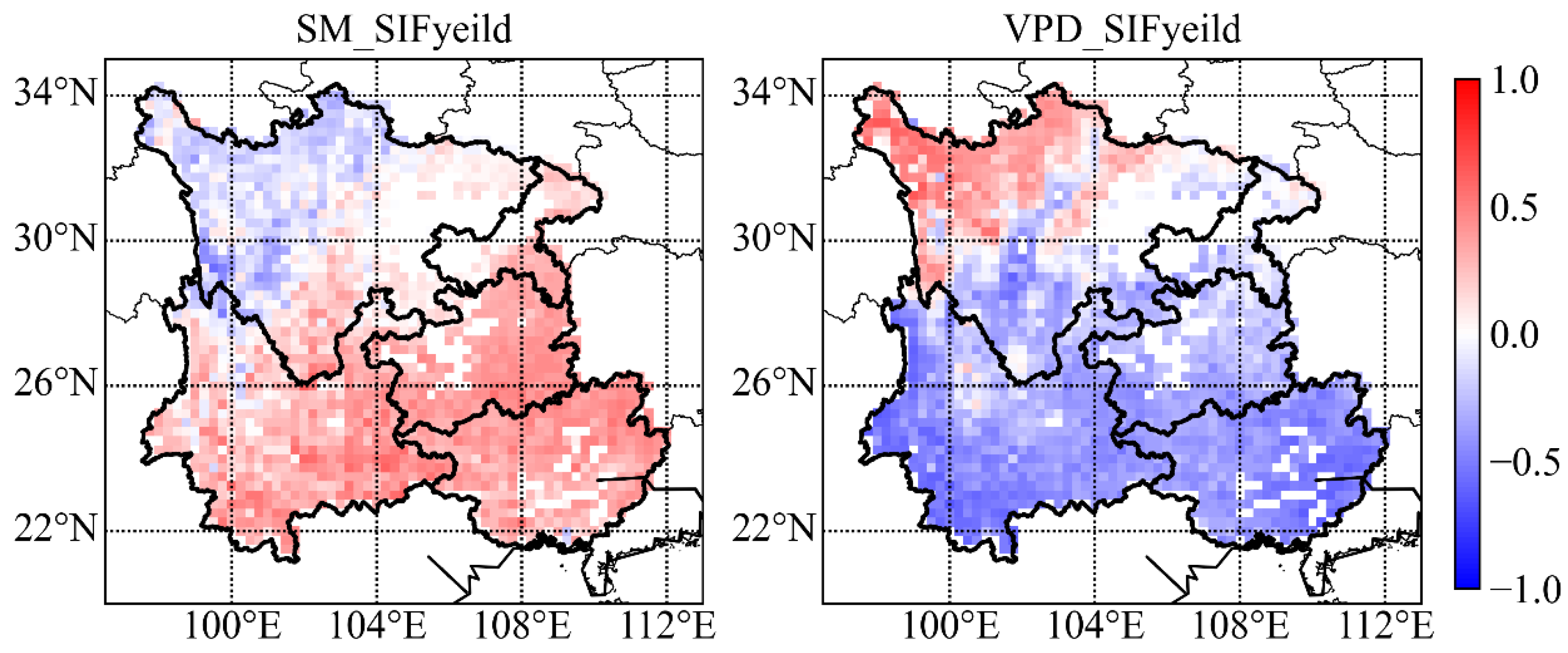The Respective Effects of Vapor Pressure Deficit and Soil Moisture on Ecosystem Productivity in Southwest China
Abstract
:1. Introduction
2. Materials and Methods
3. Study Area
4. Results
4.1. Evaluation of Simulation Results in Southwest CHINA
4.2. Spatio-Temporal Correlation Analysis of VPD, SM, and SIFyield in Southwest China
4.3. Analysis of the Respective Impact of SM and VPD on SIFyields
5. Discussion and Conclusions
Author Contributions
Funding
Data Availability Statement
Acknowledgments
Conflicts of Interest
References
- Karjalainen, T.; Kellomäki, S.; Pussinen, A. Carbon Balance in the Forest Sector in Finland during 1990–2039. Clim. Chang. 1995, 30, 451–478. [Google Scholar] [CrossRef]
- Kucharik, C.J.; Foley, J.A.; Delire, C.; Fisher, V.A.; Coe, M.T.; Lenters, J.D.; Young-Molling, C.; Ramankutty, N.; Norman, J.M.; Gower, S.T. Testing the Performance of a Dynamic Global Ecosystem Model: Water Balance, Carbon Balance, and Vegetation Structure. Glob. Biogeochem. Cycles 2000, 14, 795–825. [Google Scholar] [CrossRef]
- Huang, C.-y.; Asner, G.P.; Barger, N.N.; Neff, J.C.; Floyd, M.L. Regional Aboveground Live Carbon Losses Due to Drought-induced Tree Dieback in Piñon–Juniper Ecosystems. Remote Sens. Environ. 2010, 114, 1471–1479. [Google Scholar] [CrossRef]
- Siegert, F.; Ruecker, G.; Hinrichs, A.; Hoffmann, A. Increased Damage from Fires in Logged Forests during Droughts Caused by El Nino. Nature 2001, 414, 437–440. [Google Scholar] [CrossRef] [PubMed]
- Kuleshov, Y.; McGree, S.; Jones, D.; Charles, A.; Cottrill, A.; Prakash, B.; Atalifo, T.; Nihmei, S.; Seuseu, F.L.S.K. Extreme Weather and Climate Events and Their Impacts on Island Countries in the Western Pacific: Cyclones, Floods and Droughts. Atmos. Clim. Sci. 2014, 4, 803. [Google Scholar] [CrossRef]
- Anderegg, W.R.; Trugman, A.T.; Badgley, G.; Konings, A.G.; Shaw, J. Divergent Forest Sensitivity to Repeated Extreme Droughts. Nat. Clim. Change 2020, 10, 1091–1095. [Google Scholar] [CrossRef]
- Yang, Y.; Saatchi, S.S.; Xu, L.; Yu, Y.; Choi, S.; Phillips, N.; Kennedy, R.; Keller, M.; Knyazikhin, Y.; Myneni, R.B. Post-Drought Decline of the Amazon Carbon Sink. Nat. Commun. 2018, 9, 3172. [Google Scholar] [CrossRef] [PubMed]
- Zhang, J.; Xiao, J.; Tong, X.; Zhang, J.; Meng, P.; Li, J.; Liu, P.; Yu, P.J.A. Nirv and Sif Better Estimate Phenology than Ndvi and Evi: Effects of Spring and Autumn Phenology on Ecosystem Production of Planted Forests. Agric. For. Meteorol. 2022, 315, 108819. [Google Scholar] [CrossRef]
- Rahman, M.S.; Akter, S.; Al-Amin, M. Forest and Agro-Ecosystem Productivity in Bangladesh: A Climate Vegetation Productivity approach. For. Sci. Technol. 2015, 11, 126–132. [Google Scholar] [CrossRef]
- Liu, L.; Gudmundsson, L.; Hauser, M.; Qin, D.; Li, S.; Seneviratne, S.I. Soil Moisture Dominates Dryness Stress on Ecosystem Production Globally. Nat. Commun. 2020, 11, 4892. [Google Scholar] [CrossRef]
- Sulman, B.N.; Roman, D.T.; Yi, K.; Wang, L.; Phillips, R.P.; Novick, K.A. High Atmospheric Demand for Water can Limit Forest Carbon Uptake and Transpiration as Severely as Dry Soil. Geophys. Res. Lett. 2016, 43, 9686–9695. [Google Scholar] [CrossRef]
- Cheng, Y.; Liu, L.; Cheng, L.; Fa, K.; Liu, X.; Huo, Z.; Huang, G. A Shift in the Dominant Role of Atmospheric Vapor Pressure Deficit and Soil Moisture on Vegetation Greening in China. J. Hydrol. 2022, 615, 128–680. [Google Scholar] [CrossRef]
- Yuan, W.; Zheng, Y.; Piao, S.; Ciais, P.; Lombardozzi, D.; Wang, Y.; Ryu, Y.; Chen, G.; Dong, W.; Hu, Z. Increased Atmospheric Vapor Pressure Deficit Reduces Global Vegetation Growth. Sci. Adv. 2019, 5, eaax1396. [Google Scholar] [CrossRef] [PubMed]
- López, J.; Way, D.A.; Sadok, W. Systemic Effects of Rising Atmospheric Vapor Pressure Deficit on Plant Physiology and Productivity. Glob. Change Biol. 2021, 27, 1704–1720. [Google Scholar] [CrossRef] [PubMed]
- Zhang, S.; Bai, X.; Zhao, C.; Tan, Q.; Luo, G.; Cao, Y.; Deng, Y.; Li, Q.; Li, C.; Wu, L. Limitations of Soil Moisture and Formation Rate on Vegetation Growth in Karst Areas. Sci. Total Environ. 2022, 810, 151209. [Google Scholar] [CrossRef] [PubMed]
- Vaadia, Y.; Raney, F.C.; Hagan, R.M. Plant Water Deficits and Physiological Processes. Annu. Rev. Plant Physiol. 1961, 12, 265–292. [Google Scholar] [CrossRef]
- Churkina, G.; Running, S.W. Contrasting Climatic Controls on the Estimated Productivity of Global Terrestrial Biomes. Ecosystems 1998, 1, 206–215. [Google Scholar] [CrossRef]
- Lu, H.; Qin, Z.; Lin, S.; Chen, X.; Chen, B.; He, B.; Wei, J.; Yuan, W. Large Influence of Atmospheric Vapor Pressure Deficit on Ecosystem Production Efficiency. Nat. Commun. 2022, 13, 1653. [Google Scholar] [CrossRef] [PubMed]
- Pang, D.; Cao, J.; Dan, X.; Guan, Y.; Peng, X.; Cui, M.; Wu, X.; Zhou, J. Recovery Approach Affects Soil Quality in Fragile Karst Ecosystems of Southwest China: Implications for Vegetation Restoration. Ecol. Eng. 2018, 123, 151–160. [Google Scholar] [CrossRef]
- Sun, X.; Lai, P.; Wang, S.; Song, L.; Ma, M.; Han, X. Monitoring of Extreme Agricultural Drought of the Past 20 Years in Southwest China Using Gldas Soil Moisture. Remote Sens. 2022, 14, 1323. [Google Scholar] [CrossRef]
- Wang, W.; Wang, W.-j.; Li, J.-s.; Wu, H.; Xu, C.; Liu, T. The Impact of Sustained Drought on Vegetation Ecosystem in Southwest China Based on Remote Sensing. Procedia Environ. Sci. 2010, 2, 1679–1691. [Google Scholar] [CrossRef]
- Qiu, Z.; Feng, Z.; Song, Y.; Li, M.; Zhang, P. Carbon Sequestration Potential of Forest Vegetation in China from 2003 to 2050: Predicting Forest Vegetation Growth Based on Climate and the Environment. J. Clean. Prod. 2020, 252, 119715. [Google Scholar] [CrossRef]
- Wang, S.; Chen, J.; Ju, W.; Feng, X.; Chen, M.; Chen, P.; Yu, G. Carbon Sinks and Sources in China’s Forests during 1901–2001. J. Environ. Manag. 2007, 85, 524–537. [Google Scholar] [CrossRef]
- Cao, M.; Prince, S.D.; Li, K.; Tao, B.; Small, J.; Shao, X.J.G.C.B. Response of Terrestrial Carbon Uptake to Climate Interannual Variability in China. Glob. Change Biol. 2003, 9, 536–546. [Google Scholar] [CrossRef]
- Chen, S.; Huang, Y.; Wang, G. Detecting Drought-Induced Gpp Spatiotemporal Variabilities with Sun-Induced Chlorophyll Fluorescence during the 2009/2010 droughts in China. Ecol. Indic. 2021, 121, 107092. [Google Scholar] [CrossRef]
- Chen, N.; Song, C.; Xu, X.; Wang, X.; Cong, N.; Jiang, P.; Zu, J.; Sun, L.; Song, Y.; Zuo, Y.; et al. Divergent Impacts of Atmospheric Water Demand on Gross Primary Productivity in three Typical Ecosystems in China. Agric. For. Meteorol. 2021, 307, 108527. [Google Scholar] [CrossRef]
- Dang, C.; Shao, Z.; Huang, X.; Qian, J.; Cheng, G.; Ding, Q.; Fan, Y. Assessment of the Importance of Increasing Temperature and Decreasing Soil Moisture on Global Ecosystem Productivity Using Solar-Induced Chlorophyll Fluorescence. Glob. Chang. Biol. 2022, 28, 2066–2080. [Google Scholar] [CrossRef]
- Montané, F.; Fox, A.M.; Arellano, A.F.; MacBean, N.; Alexander, M.R.; Dye, A.; Bishop, D.A.; Trouet, V.; Babst, F.; Hessl, A.E. Evaluating the Effect of Alternative Carbon Allocation Schemes in a Land Surface Model (Clm4. 5) on Carbon Fluxes, Pools, and Turnover in Temperate Forests. Geosci. Model Dev. 2017, 10, 3499–3517. [Google Scholar] [CrossRef]
- Fox, A.M.; Hoar, T.J.; Anderson, J.L.; Arellano, A.F.; Smith, W.K.; Litvak, M.E.; MacBean, N.; Schimel, D.S.; Moore, D.J. Evaluation of a Data Assimilation System for Land Surface Models Using CLM4. 5. J. Adv. Model. Earth Syst. 2018, 10, 2471–2494. [Google Scholar] [CrossRef]
- Deng, M.; Meng, X.; Lyv, Y.; Zhao, L.; Li, Z.; Hu, Z.; Jing, H. Comparison of Soil Water and Heat Transfer Modeling over the Tibetan Plateau Using Two Community Land Surface Model (Clm) Versions. J. Adv. Model. Earth Syst. 2020, 12, e2020MS002189. [Google Scholar] [CrossRef]
- Yang, K.; Wang, C.; Li, S. Improved Simulation of Frozen-Thawing Process in Land Surface Model (Clm4. 5). J. Geophys. Res. Atmos. 2018, 123, 13–238. [Google Scholar] [CrossRef]
- Luo, S.; Fang, X.; Lyu, S.; Zhang, Y.; Chen, B. Improving Clm4. 5 Simulations of Land–Atmosphere Exchange During Freeze–Thaw Processes on the Tibetan Plateau. J. Meteorol. Res. 2017, 31, 916–930. [Google Scholar] [CrossRef]
- Li, X.; Xiao, J.; He, B. Higher Absorbed Solar Radiation Partly Offset the Negative Effects of Water Stress on the Photosynthesis of Amazon Forests during the 2015 Drought. Environ. Res. Lett. 2018, 13, 044005. [Google Scholar] [CrossRef]
- Pei, Y.; Dong, J.; Zhang, Y.; Yuan, W.; Doughty, R.; Yang, J.; Zhou, D.; Zhang, L.; Xiao, X. Evolution of Light Use Efficiency Models: Improvement, Uncertainties, and Implications. Agric. For. Meteorol. 2022, 317, 108905. [Google Scholar] [CrossRef]
- Xu, S.; Gentine, P.; Li, L.; Wang, L.; Yu, Z.; Dong, N.; Ju, Q.; Zhang, Y. Response of Ecosystem Productivity to High Vapor Pressure Deficit and Low Soil Moisture: Lessons Learned From the Global Eddy-Covariance Observations. Earth’s Future 2023, 11, e2022EF003252. [Google Scholar] [CrossRef]
- Zhang, W.; Luo, G.; Hamdi, R.; Ma, X.; Termonia, P.; De Maeyer, P. Drought Changes the Dominant Water Stress on the Grassland and forest Production in the Northern Hemisphere. Agric. For. Meteorol. 2024, 345, 109831. [Google Scholar] [CrossRef]
- Sun, Y.; Frankenberg, C.; Jung, M.; Joiner, J.; Guanter, L.; Köhler, P.; Magney, T. Overview of Solar-Induced Chlorophyll Fluorescence (Sif) from the Orbiting Carbon Observatory-2: Retrieval, Cross-Mission Comparison, and Global Monitoring for GPP. Remote Sens. Environ. 2018, 209, 808–823. [Google Scholar] [CrossRef]
- Gao, H.; Liu, S.; Lu, W.; Smith, A.R.; Valbuena, R.; Yan, W.; Wang, Z.; Xiao, L.; Peng, X.; Li, Q. Global Analysis of the Relationship between Reconstructed Solar-Induced Chlorophyll Fluorescence (Sif) and Gross Primary Production (GPP). Remote Sens. 2021, 13, 2824. [Google Scholar] [CrossRef]
- Chen, X.; Huang, Y.; Nie, C.; Zhang, S.; Wang, G.; Chen, S.; Chen, Z. A long-Term Reconstructed TROPOMI Solar-Induced Fluorescence Dataset Using Machine Learning Algorithms. Sci. Data 2022, 9, 427. [Google Scholar] [CrossRef] [PubMed]
- Jia, K.; Yang, L.; Liang, S.; Xiao, Z.; Zhao, X.; Yao, Y.; Zhang, X.; Jiang, B.; Liu, D. Long-Term Global Land Surface Satellite (Glass) Fractional Vegetation Cover Product Derived from Modis and Avhrr Data. IEEE J. Sel. Top. Appl. Earth Obs. Remote Sens. 2019, 12, 508–518. [Google Scholar] [CrossRef]
- Broxton, P.D.; Zeng, X.; Sulla-Menashe, D.; Troch, P.A. A Global Land Cover Climatology Using MODIS Data. J. Appl. Meteorol. Climatol. 2014, 53, 1593–1605. [Google Scholar] [CrossRef]
- Lin, W.; Wen, C.; Wen, Z.; Gang, H. Drought in Southwest China: A review. Atmos. Ocean. Sci. Lett. 2015, 8, 339–344. [Google Scholar]
- Zhang, S.-B.; Zhou, Z.-K.; Hu, H.; Xu, K.; Yan, N.; Li, S.-Y. Photosynthetic Performances of Quercus Pannosa Vary with Altitude in the Hengduan Mountains, Southwest China. For. Ecol. Manag. 2005, 212, 291–301. [Google Scholar] [CrossRef]
- Zhou, Q.; Luo, Y.; Zhou, X.; Cai, M.; Zhao, C. Response of Vegetation to Water Balance Conditions at Different Time Scales across the Karst Area of Southwestern China—A Remote Sensing Approach. Sci. Total Environ. 2018, 645, 460–470. [Google Scholar] [CrossRef] [PubMed]
- Fan, J.; Wu, L.; Zhang, F.; Xiang, Y.; Zheng, J. Climate Change Effects on Reference Crop Evapotranspiration across Different Climatic Zones of China during 1956–2015. J. Hydrol. 2016, 542, 923–937. [Google Scholar] [CrossRef]
- Jiang, S.; Chen, X.; Smettem, K.; Wang, T. Climate and Land Use Influences on Changing Spatiotemporal Patterns of Mountain Vegetation Cover in Southwest China. Ecol. Indic. 2021, 121, 107193. [Google Scholar] [CrossRef]
- Qin, N.; Chen, X.; Fu, G.; Zhai, J.; Xue, X. Precipitation and Temperature Trends for the Southwest China: 1960–2007. Hydrol. Process. 2010, 24, 3733–3744. [Google Scholar] [CrossRef]












| Area | R | RMSE | MAE | |
|---|---|---|---|---|
| Yunnan | GLDAS | 0.843 * | 0.047 | 0.0014 |
| ERA5 | 0.718 * | 0.051 | 0.0026 | |
| Chuanyu | GLDAS | 0.719 * | 0.045 | 0.0024 |
| ERA5 | 0.689 * | 0.032 | 0.0010 | |
| Guizhou | GLDAS | 0.816 * | 0.040 | 0.0031 |
| ERA5 | 0.70 * | 0.052 | 0.0027 | |
| Guangxi | GLDAS | 0.86 * | 0.047 | 0.0036 |
| ERA5 | 0.701 * | 0.052 | 0.0027 |
| Area | R | RMSE | MAE |
|---|---|---|---|
| Yunnan | 0.6811 * | 0.0572 | 0.0032 |
| Chuanyu | 0.6027 * | 0.0719 | 0.0049 |
| Guizhou | 0.7217 * | 0.0405 | 0.0016 |
| Forest | Shrub | Grassland | |
|---|---|---|---|
| VPD_bins | 0.083 | 0.063 | 0.018 |
| SM_bins | 0.043 | 0.026 | 0.024 |
Disclaimer/Publisher’s Note: The statements, opinions and data contained in all publications are solely those of the individual author(s) and contributor(s) and not of MDPI and/or the editor(s). MDPI and/or the editor(s) disclaim responsibility for any injury to people or property resulting from any ideas, methods, instructions or products referred to in the content. |
© 2024 by the authors. Licensee MDPI, Basel, Switzerland. This article is an open access article distributed under the terms and conditions of the Creative Commons Attribution (CC BY) license (https://creativecommons.org/licenses/by/4.0/).
Share and Cite
Sun, X.; Xiao, Y.; Wang, J.; Zhou, M.; Song, Z.; Ma, M.; Han, X. The Respective Effects of Vapor Pressure Deficit and Soil Moisture on Ecosystem Productivity in Southwest China. Remote Sens. 2024, 16, 1316. https://doi.org/10.3390/rs16081316
Sun X, Xiao Y, Wang J, Zhou M, Song Z, Ma M, Han X. The Respective Effects of Vapor Pressure Deficit and Soil Moisture on Ecosystem Productivity in Southwest China. Remote Sensing. 2024; 16(8):1316. https://doi.org/10.3390/rs16081316
Chicago/Turabian StyleSun, Xupeng, Yao Xiao, Jinghan Wang, Miaohang Zhou, Zengjing Song, Mingguo Ma, and Xujun Han. 2024. "The Respective Effects of Vapor Pressure Deficit and Soil Moisture on Ecosystem Productivity in Southwest China" Remote Sensing 16, no. 8: 1316. https://doi.org/10.3390/rs16081316
APA StyleSun, X., Xiao, Y., Wang, J., Zhou, M., Song, Z., Ma, M., & Han, X. (2024). The Respective Effects of Vapor Pressure Deficit and Soil Moisture on Ecosystem Productivity in Southwest China. Remote Sensing, 16(8), 1316. https://doi.org/10.3390/rs16081316







